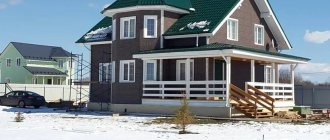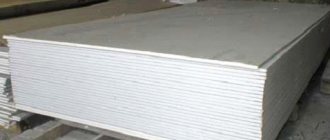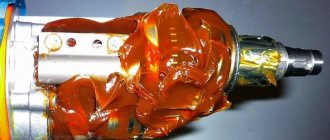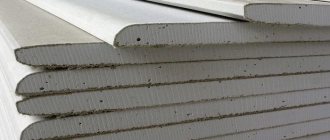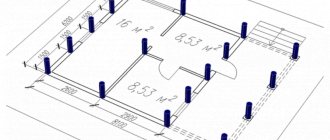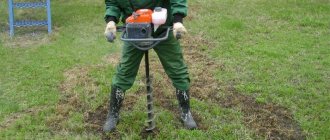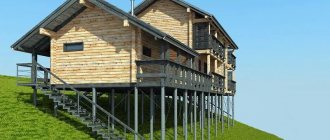Organization of electrical safety is one of the main requirements when commissioning residential premises, private houses or detached outbuildings. A lightning strike or short circuit can lead not only to material losses, but also lead to more tragic consequences. Such cases can be prevented by constructing a reliable grounding loop. Among the many options for its design, some professional builders recommend using screw piles as grounding electrodes. However, experts working in the electrical industry question the advisability of such use of products, so there is no consensus on this matter.
If you want to make a grounding device from screw piles
A grounding loop made of screw piles, which serve as vertical conductors in it.
This inconvenience can be completely eliminated if you buy a screw pile that does not need to be driven. Products of SHS or other modifications are screwed in alone with an electric drill with a multiplier (torque amplifier) or manually (you will need crowbars and two assistants).
When constructing grounding on your own, you should take into account the recommended cross-sections of vertical conductors depending on the rolled metal used:
- strip – minimum 12 x 4 mm
- rod – 3.6 mm
- corner – 40 x 40 mm
- pipe – wall thickness minimum 3.5 mm
Manufacturers usually make screw piles from thick-walled pipe with a minimum of 4 mm wall. Therefore, there are no problems; you can buy SHS of the minimum diameter from the available assortment with a length of 2-3 m.
A little history
Screw-type piles appeared about 200 years ago.
All this time, they were widely used in the construction of bridges, piers, towers, power lines and many other serious objects. There is a lot of evidence that the service life of screw piles can be up to 150 years. For example, the pier, which has been standing in sea water on similar supports for more than a century and a half, has not yet collapsed.
There are entire museums where visitors can personally examine the tips of the very first screw piles. However, this does not mean that metal structures will last forever. Negative reviews about the service life of screw piles are quite justified, since the supports made using handicraft methods actually collapse quite quickly.
The manufacturing technology of building structures has a lot of nuances and features. If production standards were violated, then the finished piles will not last even a third of the declared period. Therefore, it is very important to pay attention to these subtleties when choosing structures for the foundation.
Screw pile foundation and grounding
Screw piles that can be used for grounding should not have dielectric coatings applied.
For grounding a house, the most justified is the use of galvanized screw piles. There are different technologies for applying such anti-corrosion coating:
- cold galvanizing method, in which the protective layer is applied using zinc-containing paints;
- hot galvanizing, which involves coating the product with hot zinc in industrial production conditions.
When solving the problem of foundation grounding, it is necessary to be guided by the requirements of the Electrical Installation Rules (ELR).
The regulations require the construction of the grounding loop of buildings only as a separate structure! Thus, it is strictly not recommended to make any connections directly to the pile field itself or to the screw foundation strip.
How to increase the service life of a foundation structure?
Each developer can extend the useful life of the foundation structure. To do this, it is necessary to protect screw piles from aggressive environmental influences:
The internal cavities of metal piles can be filled with cement mortar. In this case, the concrete will prevent corrosive destruction of the piles. The surfaces of the supports can be processed by cold galvanizing. This method is advisable if during operation there will be minimal negative impact on the foundation structure. The useful life of metal supports can be increased by using the hot method of applying zinc coating.
This technology will allow maintaining all the important characteristics of piles for 120 years. Timely treatment with epoxy resins will help increase the service life of screw supports. Such a protective coating will remain sealed for 50 years. Developers can treat the surfaces of metal supports with resins that contain polyurethane. This component will provide the protective coating with maximum adhesion, so that the metal will not come into contact with a damp environment for 50 years.
Every developer who decides to build a screw pile structure must understand that without special protection, the supports will be subject to intense corrosion. This process results in an annual reduction in pile thickness of at least 30 microns.
Timely measures aimed at creating a protective coating that will prevent access of oxygen to the metal can slow down the development of corrosion processes.
Screw pile foundation and its grounding
Many people wonder: is a pile foundation on screw piles suitable for organizing reliable grounding? On the one hand, the deep location of the pile foundation is a circumstance that points in favor of creating a reliable grounding system.
Thus, grounding a pile foundation on screw piles is a valid option only in the absence of dielectric coatings. To protect piles from corrosion, special conductive paints or galvanized coating are needed.
Note! Some construction companies, wanting to save money, use cheap types of paint and varnish materials to paint piles. As a result, the coating is sprinkled already at the stage of screwing the support into the ground.
Useful life
Many developers planning to begin construction of residential or industrial facilities are primarily interested in the useful life of a screw foundation. The durability of such a supporting structure is directly affected by the following factors:
- Low acidity of the soil, due to which the supports weaken faster under the influence of corrosion. The proximity of groundwater or other sources of moisture, which are the main cause of rust on piles. The presence of rocky fragments in the soil, the sharp edges of which damage the protective coating and allow moisture to enter welded seams. Temperature fluctuations, which lead to constant compression and expansion of metal structures, due to which their integrity slowly begins to deteriorate. Shrinkage of a building erected on soft soil can cause deformation of metal supports. Violation of technology in the process of constructing a foundation structure, in particularly when deepening piles into the soil.
If the developer correctly carries out all the work related to the construction of the foundation, then the service life of the screw piles will be at least 30 years.
Checking the grounding system
When the installation is completed, you need to test the resistance of the ground loop. In accordance with the rules for electrical installations, the resistance indicator for an electrical network with a voltage of 220 Volts should not exceed 30 Ohms.
Measurements are carried out in dry weather (during such periods the greatest soil resistance is observed). If the measurement results are within the normal range, the trench with the grounding loop is covered with earth, after which the grounding is ready for operation.
Grounding connection rules
What is the problem, why can’t you connect the ground wire to heating or water supply pipes?
And now the question is - what will happen to the neighbor if he, sitting in the bathroom (connected to the sewer by opening the plug) touches the tap? Did you guess it?
The prize is prison. Under an article about violation of electrical safety rules resulting in casualties.
"Grounding" and "grounding"
Ideally, the “grounding loop” should consist of 3 - 4 corners, which are welded with a metal strip of the same width. The distance between the corners should be 2 m.
Just don’t drill a hole in the ground with a meter-long drill and lower the pin there. It is not right. And the efficiency of such grounding is close to zero.
But, as with any method, there are downsides. You are, of course, lucky if you live in a private house, or at least on the first floor. But what about those who live on the 7th-8th floor? Should you stock up on 30-meter wire?
So how to find a way out of this situation? I’m afraid that even the most experienced electricians will not give you the answer to this question.
What is required for house wiring
We must also not forget that the “earth” has no right to be broken by means of any switches.
Answer
Leave your tips and comments below. Subscribe to our newsletter. Good luck to you and good luck to your family!
- Question: Can a water well casing be used as a ground electrode?
- What is and how to do zeroing
- Question: We need a staircase to the second floor, there is not enough space
- What kind of foundation for a garage should be made from FBS blocks?
- How to insulate a bath
- What is the minimum slope of a gable roof for normal snow melting?
- How to make, build a fence from corrugated sheets with your own hands
- How to build a 10x20 m garage from a met sandwich. frame?
- Question: Which roof design is best for an extension?
- Question: There is no ventilation in the apartment, how can I do it?
- Load on the septic tank lid from cars passing over it
- Question: How to repair and insulate a roof
- How to navigate by the stars and moon
- Question: About waterproofing and flooring in a cellar on the river bank
- Vegetable storage in the basement (raise and insulate the walls, arrange ventilation)
- Siding frame for a house made of foam blocks
This can lead to accelerated wear of the piles due to increased corrosion, especially if there are current leaks to the ground. It is better to arrange a separate grounding.
Step-by-step foundation technology on screw piles
Thanks to a fairly simple design, if you have the necessary tools and equipment (welding machine, gas cutter), screw foundations can be made at home. Installation is carried out using the following technology:
Calculation of a pile-screw foundation
The technology has been sufficiently developed in all regions of the Russian Federation; to calculate the SVF, you can use the SP from 2011, number 24. 13330 for pile foundations. The main calculations are:
In order not to order expensive geological surveys of the site, in 75% of cases a trial screw-in is used, which allows one to calculate the data necessary for the project:
- depth of the bearing layer (necessarily below the freezing level of the region);
- soil composition (presence of large stones, gravel, limestone in different layers);
- GWL level (very conditional).
The main characteristics of piles are indicated by manufacturers. For example, the dimensions of the SHS are selected based on the type of structure for which a foundation is needed:
Thus, after calculating the prefabricated loads (operational + wind + structural + snow), the figure is divided by the load-bearing capacity of the pile to calculate the required number of SHS.
Preparation and marking of the site
Driving piles
Step-by-step instructions for screwing in SHS, regardless of the type of blades, tip, groundwater level, and other factors, are as follows:
There is a technology for mechanical immersion of SHS without the use of special equipment, which slightly increases the construction budget:
The torque amplifier device is a gearbox with a gear ratio of 1/60. Instead of levers, an electric tool drive is used; the operation can be performed by two workers.
Alignment of SHS in the horizontal plane
The pile field must be tied with a grillage in the form of concrete, metal or wooden beams located on the heads. To do this, the pipes protruding from the ground must be brought back to normal. The leveling technology looks like:
- single level mark - use a level, theodolite or laser plane builder, level;
- trimming - the body of the pipe is cut with an angle grinder according to the markings.
This element is put on the SHS body and attached to it by welding (less often with bolts). The holes in the plate allow you to fix the wooden beams of the grillage to obtain a single spatial structure.
Pouring concrete
The pile, even with a hermetically welded head, is covered with moisture from the inside. To prevent this phenomenon, special protection is used - filling the pile body with concrete after immersion to the design depth. Several technologies are usually used:
In addition, concrete injections make it possible to increase the spatial rigidity of the structure, which is important for thin-walled piles.
Tying piles with a grillage
Monolithic grillage
The technology is the most complex and is more expensive than other options, but it is the only one possible for brick cottages on difficult terrain, in the coastal strip and in swamps. Installation of a monolithic grillage using technology:
All types of masonry for the walls of a brick house and any other construction technologies are allowed on a monolithic grillage.
Wooden grillage
The manufacturing technology looks like:
- installation of flat heads - necessary to increase the area of the supporting surface;
- laying beams - beams, logs are joined into half a tree, attached to the heads with self-tapping screws, bolts or nails.
This is the fastest grillage device, however, the technology is unsuitable for brickwork and high-rise projects. The height of the building cannot exceed one floor with an attic.
Metal grillage
If the height of the log house or “frame” exceeds the standard floor, the wooden grillage may not withstand prefabricated loads. It is not economically profitable to pour monolithic beams for wooden buildings; you can use a grillage made of rolled metal. The technology looks like:
- laying pieces of channel with shelves down, wall up on SHS pipes or I-beams on the bottom shelf in exactly the same way;
- joining grillage elements, tack welding in several places;
- double welding of each joint.
A metal grillage is suitable for one-story brick buildings only if the pitch of the pile field is reduced to 1 - 1.5 m. This is due to the large structural mass of the material - for example, the channel begins to bend under its own weight already in 3 m spans.
Insertion of engineering systems into a building on screw piles
Climbing on screw piles
There is no full-fledged base in the pile foundations; a fence is made to protect against blowing and penetration of precipitation into the underground. Several technologies can be used to build a false plinth:
- frame system - a beam or galvanized profile is attached to the piles, the lattice is sheathed with basement siding, corrugated sheets, panels;
- masonry - ceramic, clay brick, rubble stone.
The intake is complemented by a blind area for drainage of storm and flood runoff. The facing materials of these structures must be waterproofed. To do this you need:
- install frame sheathing;
- fix the roofing material vertically on it;
- run it under a horizontal blind area;
- install siding and paving slabs.
Natural ventilation of the underground is carried out due to the vents left in the false base, the total area of which should be equal to 1/400 of the surface of the intake. There is no need to insulate the structure, since there is no heating inside the underground.
Which grillage is better to choose?
Experts recognize that a pile-grillage foundation is an ideal option for structures made of frames, bricks or blocks that will be built on sand, loam, and sandy loam. In this case, the ratio of the following indicators is also ideal - cost, quality characteristics and reliability.
For the construction of a small and relatively light structure, it will be enough to use up to 100 piles, the diameter of which will be no more than 200 mm, but in the case when greater load-bearing capacity is required, the following move is used - the base of the piles is increased to a value of 400 mm. It is also worth noting that there are only two options for constructing a grillage - monolithic and hanging, which have their own advantages and disadvantages.
Hanging
The design of a hanging-type pile-grillage foundation is a foundation in which there is a small gap directly between the grillage and the soil itself (it is this that prevents the soil from affecting the foundation if it swells). This type of grillage is considered very economical, because in this case the walls of the well act as formwork.
To prevent the cement laitance from leaking out, a cover is made from roofing felt (sometimes polyethylene foam is also used), which covers the inside of the well. Since such a foundation can only be built on sufficiently strong soils, this option is rarely used. In order to determine how practical the foundation is, the pros and cons of a grillage foundation on piles need to be considered in more detail.
Monolithic
In this case, the formwork is pipes made of various materials (metal, cardboard or asbestos cement), and their diameters are different. To ensure a strong structure, reinforcement cages become an indispensable component of the grillage device under consideration.
Concrete piles are more susceptible to corrosion - myth or reality?
It would seem that the technology is simple and necessary, but its feasibility, however, has been questioned. Some companies do not use concreting of the pile shaft, since, from their point of view, it reduces the service life of the foundation. This opinion is supported by the fact that metal and concrete have different coefficients of thermal expansion. Because of this discrepancy, microgaps are allegedly formed in which moisture accumulates, and in the presence of oxygen access, corrosion proceeds at an accelerated pace.
These arguments have no basis in reality and are easily refuted. The coefficients of linear thermal expansion of steel and concrete differ little from each other, and the existing insignificant difference cannot cause a conflict of materials. Structures made of steel and concrete behave similarly to homogeneous structures both at subzero temperatures and under non-stationary thermal conditions. This is what makes it possible to use such materials as reinforced concrete and pipe concrete.
Even if cavities remain in the concrete solution, the absence of the possibility of air penetration will minimize the likelihood of condensation forming in them on the inner wall of the trunk. When pouring the cast solution, air is displaced from the barrel and the formation of cavities becomes unlikely. The main advantage of this technology is that concrete is an alkaline medium (pH more than 7 units) and prevents metal corrosion processes. For example, in reinforced concrete, the reinforcement is preserved due to the presence of a protective layer of concrete several centimeters thick, which ensures the presence of an alkaline environment around the steel rods. Corrosion of reinforcement in reinforced concrete is possible only in the presence of highly aggressive environments or a change in pH level downward due to carbonization. This is only possible in open contact with air or water. Therefore, water that gets into the cavities, cracks and gaps of the hardened concrete inside the pipe does not change the pH level. Concrete does not have a negative effect on the metal, but is a protective medium.
Brands of concrete used
Before starting work, you need to find out which concrete is best used to strengthen the screw post. Usually, low-fraction concrete M200, M300 is used for concreting.
Composition of concrete M200.
Brand M200 is most often used for the construction of one-story or two-story houses with light ceilings. This brand is used when working with reinforced concrete products; according to its strength characteristics, it is classified as structural.
The M300 grade is suitable for the construction of foundations for private houses up to five floors high. It is recommended to adapt such concrete to monolithic types of floors.
Pouring bored piles with a widened heel
Attachment to the drill to create a widening of the support heel. The expanded base of the well is made in three ways:
- The bottom of the well is filled with layers of concrete solution 200-300 mm thick and with increased pressure the solution squeezes out the surrounding soil, forming a widened base.
- The heel is formed using a special cutting device. The folding cutting element, fixed to the drill string, opens at the desired depth. Rotating, the knife expands the size of the base across the well from 2 to 3 meters. The knife is driven by a hydraulic mechanism with remote control.
- The base of the well is widened using the explosive method. The explosive is activated by a remote installation and a spherical depression is formed.
After this, the well cavity is reinforced and the shaft with installed reinforcement is filled with concrete.
We recommend watching a video of how to fill a support with an extended heel.
